Creative Evolutions
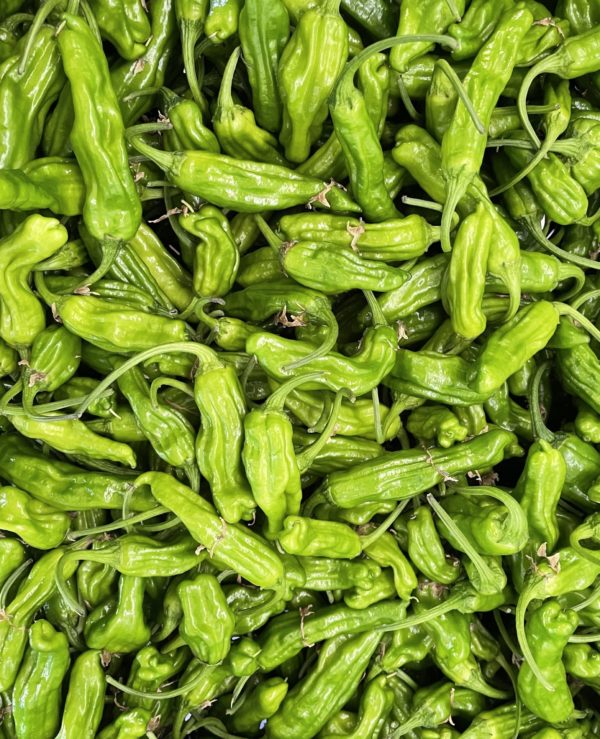
Borders are interesting places. Yes, borders divide people into one side and the other side, but borders are also places where different cultures make contact. Misunderstandings abound along frontiers, but so do creative evolutions. The Pacific ocean has acted like a vast border but it has also been the connective medium between the Americas and Asia, and this week’s harvest box underscores that relationship. Take the shishito pepper, for example.
We think of the shishito as a “Japanese pepper” — I get my seed from Kitazawa Seeds, in Oakland, a company that specializes in Asian vegetable varieties — but a botanist will tell you that everything about peppers are American in origin, except the name. Columbus had investors who financed his voyages to the “Indies.” He couldn’t afford to disappoint the powerful people who placed bets on his dream. Vast profits were going to be realized by crossing the Atlantic from Western Europe to India and returning home with cargoes of Piper nigrum, or Black Pepper, deftly cutting the Muslim traders out of the spice trade by making their overland routes from Asia irrelevant. So when Columbus careened into seas and lands that were new to him, a new world devoid of even a single grain of Black pepper, he had to talk fast. The locals got called “Indians” and the spicy fruits that they cultivated got the name of “peppers.”
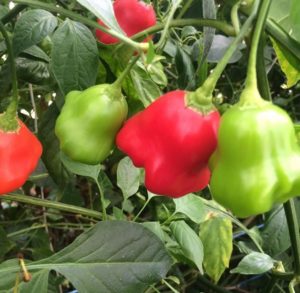
Habanero peppers
Back in Europe, the people were hesitant to accept this hustle and the new “peppers” only gained acceptance slowly, which is not surprising considering the ignorant and religious context of the age. Any plant not mentioned in the Bible could reasonably be defined and feared as “Satanic.” In today’s marketplace, we have a myriad of different kinds of peppers available, from the tame Bell pepper to the fiery Habaneros, but it’s worth remembering that every basic form of this widely variable plant had already been developed by the Native American farmers. Asian cooks didn’t have the same prejudices as their European counterparts and the new American “peppers” found a ready place in the kitchen. The Japanese are not known for their dependence on picante flavors and they adopted a mild type of immature, green pepper as their own, selecting and improving it to make it conform to their tastes, dubbing it the “shishito.”
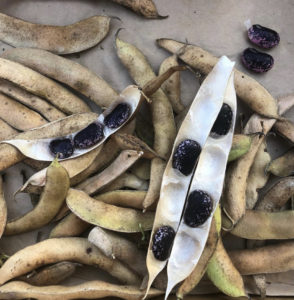
Akahana beans
A similar dynamic occurred with the runner bean. Beans, like peppers, tomatoes, potatoes, sunflowers, corn and squashes, were originally developed by Native American farmers. The “old” world had pulses, like peas, lentils, garbanzos, and soy, but they did not have the Phaseolus beans like the Kidney bean, the green bean, or the runner bean. Compared to many other legumes, runner beans prefer a cooler environment to grow in. The cool highlands of Central America, from Oaxaca down through Guatemala, were home to a tribe of rambling, scrambling, climbing, vining beans now known as “runner beans.” The Scarlet runner bean earns its name by virtue of its brilliant scarlet flower. It has a white flowered cousin known as the white runner bean. These beans found favor among Japanese farmers due to the large size of their seeds and their mild flavor and velvety texture once cooked. The Japanese selected and improved the new American beans to suit their taste, and called the purple seeded form the “Akahana mame” and the white seeded bean the “Shirohana mame.”
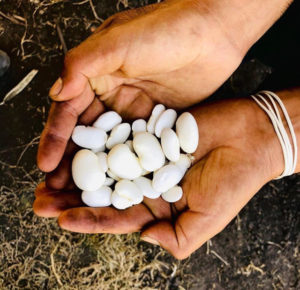
Shirohana beans
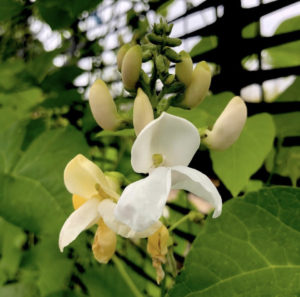
Shirohana flower
Thank you for your support this season. We’ll be closing the farm down for a bit to rest, regroup, and come up with a new business plan. Work will not stop during our shut down, but Starling and I will be down on a border ourselves, visiting Organ Pipe National Monument on the Mexican border to see some cacti, dropping in on the Everglades to visit with family and see some alligators, and hopefully even venture out to the Florida Keys and the Dry Tortugas National Park to gaze out across the Caribbean and make plans for the future.
 We wish you happy holidays and a healthy, peaceful winter!
We wish you happy holidays and a healthy, peaceful winter!
Andy and the Crew at Mariquita Farm


